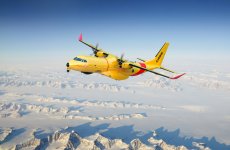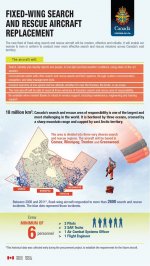Search and rescue is an essential public service for Canadians from coast to coast to coast. That’s why the Government of Canada is building a more agile, better-equipped military, while ensuring the best value for Canadians.
Following a rigorous, open and transparent competition, the Government of Canada today announced the awarding of a contract for $2.4 billion to Airbus Defence and Space to replace Canada’s fleets of CC115 Buffalo and legacy CC130 Hercules aircraft. The company has partnered with Newfoundland-based PAL Aerospace for maintenance and support services.The contract will provide a complete, modern and technologically advanced search and rescue solution, including maintenance and support services up to 2043.
As part of this contract, Airbus will provide 16 C295W aircraft, equipped with advanced technology systems, to support Canada’s search and rescue operations, construct a new simulator-equipped training centre in Comox, British Columbia, and provide ongoing maintenance and support services. The contract also includes options to extend the maintenance and support services for an additional 15 years. Should Canada choose to exercise these additional options, the contract value would increase to $4.7 billion.
The new technology being acquired includes state-of-the-art communications systems that will allow search and rescue personnel to share real-time information with partners on the ground. Using integrated sensors, crews will be able to locate persons or objects, such as downed aircraft, from more than 40 kilometres away, even in low-light conditions.
As part of its proposal Airbus Defence and Space has committed to make investments in the Canadian economy equal to the value of the contract, creating and maintaining good middle class jobs. Through Canada’s Industrial and Technological Benefits Policy, the company will incorporate many of Canada’s leading aerospace firms into its global supply chain and establish strategic partnerships with Canadian companies to ensure the aircraft are supported in Canada by Canadians. This work will help grow Canada’s innovative and strong aerospace sector, while providing well-paying jobs for the middle class and those working hard to join it.
Quotes
“"In a country as large as Canada, our search and rescue personnel must have the right equipment to face the varying challenges they encounter every day. Working closely with partners through a fair, open competition, we have selected aircraft and advanced technology that will ensure the safety of Canadians from coast to coast to coast while providing good middle class jobs."”
The Honourable Judy M. Foote
Minister of Public Services and Procurement
“"Members of the Royal Canadian Air Force search and rescue community are among the best trained in the world and respond to incidents in every type of environment, whether in the Arctic, over the Rockies or in the middle of the ocean. Canadians in distress can count on them to give their very best to save lives. With this technology, we are giving our women and men in uniform the tools they need to continue to deliver effective and essential search and rescue operations."”
The Honourable Harjit S. Sajjan
Minister of National Defence
“"Through the Industrial and Technological Benefits Policy, 100 percent of the contract value will be invested into the Canadian economy. Airbus Defence and Space will ensure that the maintenance, training, repair and overhaul work of the aircraft are performed in Canada which will create high-value, well-paying jobs for middle class Canadians and generate sustainability and growth for Canada’s aerospace and defence sector."”
The Honourable Navdeep Bains
Minister of Innovation, Science and Economic Development
Quick Facts
The Canadian Armed Forces is responsible for providing aeronautical search and rescue operations. In collaboration with federal, provincial/territorial and municipal governments, as well as local search and rescue organizations, the Armed Forces respond to Canadians in distress across the country and at sea.
The initial contract for a period of 11 years is valued at $2.4 billion (plus applicable taxes) and includes 6 years of acquisition and set up, including the construction of a new training centre in Comox, British Columbia, as well as the first 5 years of maintenance and support services.
The contract is performance-based, which means the contractor will only be paid when equipment and services are delivered and accepted by Canada.
The contract also includes options to extend the maintenance and support services for an additional 15 years. Should Canada choose to exercise these additional options, the contract value would increase to $4.7 billion (plus applicable taxes).
A fairness monitor was engaged to oversee and report on the openness and transparency of the procurement process. The fairness monitor’s report identified no fairness‑related issues.
Canada’s CC115 Buffalo and CC130 Hercules have served Canada well over the last 20 to 40 years. These aircraft perform over 350 missions annually and are responsible for saving thousands of Canadian lives every year.
During the transition the existing fleets will continue to be maintained and operated to ensure search and rescue responsibilities.
Related Products
Backgrounder:
A modern and effective search and rescue solution for the Canadian Armed Forces
Backgrounder:
Fixed-wing search and rescue aircraft procurement process
Infographic: Procuring Canada’s future fixed-wing search and rescue aircraft
(attached PDF)
Infographic: Capability
(attached JPEG)



